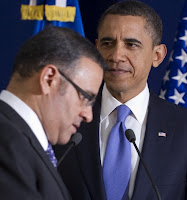President Obama visits rebel-controlled territory - El Salvador
Amidst historic uprisings in Tunisia and Egypt, President Barack Obama is on a Latin America tour, including a stop in El Salvador, which elected former rebel leaders to the presidency in 2009. The stopover in El Salvador includes a press conference with President Mauricio Funes and a visit to the tomb of Salvadoran Archbishop Oscar A. Romero. It's amazing that Obama is visiting El Salvador, given the US history of supporting attacks on the Salvadoran people and an armed rebellion that took place between 1977 and 1992.
During the Carter, Reagan, and Bush Sr. administrations, all methods of US government and military intervention took place across the Central America region, including the direct invasion of Grenada in 1983 and Panama in 1989. The intervention quashed legitimate rebellions against oppression.
75,000 Salvadorans were killed in the conflict, mostly civilians at the hands of US-sponsored paramilitary death squads. Nicaragua's revolution in 1979, overcoming 40 years of US-supported dictatorship, was greeted with US funding and training of contra terrorists. The terror attacks lead to the deaths of 30,000 Nicaragurans. Honduras became a US military base for contra attacks in Nicaragua. 100,000 Guatemalans were killed during the reign of terror in that country.
That was how the United States dealt with rebellion in one of the poorest regions of the world.
Fast-forward to 2011: President Obama's tour stop in El Salvador is seen as a symbolic move by some observers:
----------------
[1] "Obama’s Visit to El Salvador," Peace and Conflict Monitor, http://www.monitor.upeace.org/innerpg.cfm?id_article=787
[2] "Oscar Romero," http://en.wikipedia.org/wiki/%C3%93scar_Romero
[3] "Obama lauds Latin American democracies as role models for the Middle East," http://www.washingtonpost.com/world/obama-lauds-latin-american-democracies-defends-libya-action-during-chile-visit/2011/03/21/ABL0RY8_story.html
 |
| President Mauricio Funes of El Salvador (left) with President Barack Obama at a joint press conference in San Salvador (3/22/11). |
75,000 Salvadorans were killed in the conflict, mostly civilians at the hands of US-sponsored paramilitary death squads. Nicaragua's revolution in 1979, overcoming 40 years of US-supported dictatorship, was greeted with US funding and training of contra terrorists. The terror attacks lead to the deaths of 30,000 Nicaragurans. Honduras became a US military base for contra attacks in Nicaragua. 100,000 Guatemalans were killed during the reign of terror in that country.
That was how the United States dealt with rebellion in one of the poorest regions of the world.
Fast-forward to 2011: President Obama's tour stop in El Salvador is seen as a symbolic move by some observers:
El Salvador may be seen by Obama and his advisors as an example of acceptable political change in the region, based on conflict transformation and democracy building, which could inspire a new kind of alliance between the US and other countries with small economies and huge social problems.On another level the tour to El Salvador, essentially rebel-controlled territory, represents a bold move by Obama to acknowledge a new reality in geopolitics, especially in light of North African and Mideast rebellions.
Last but not least, Obama promised changes in all political actions. This visit is an opportunity for him to live up to those promises of change in terms of US foreign policy in Central America, which has had a regretful history of supporting bloody and cruel military dictatorships across the region, as well as being involved in the Iran-Contra affair. [1]
Obama will gain credibility for his promises and demonstrate that, as part of a new political style, he is able to transform a longstanding source of tension into a fruitful relationship; a former enemy into a strategic ally. The US government cannot forget the significance of the votes of Salvadoran born citizens and voters with Salvadoran background, plus the increasing number of Salvadoran-born legislators and municipal government officials.Participants in El Salvador's uprising in the 1970's and 80's were dealt with in a brutal fashion by US-trained and funded paramilitary death squads. The death squads rampaged the cities and countryside, brutally murdering thousands of peasant leaders, teachers, and labor organizers. At the height of abomination, death squads boldly assassinated the top Catholic clergy-person, Archbishop Oscar Romero. US support for the Salvadoran government and military was uninterrupted despite a widespread attacks on faith leaders.
Emblematic and symbolic is the visit that Obama will make to the tomb of Monsignor Romero. Monsignor is now a universal personality for having been killed three decades ago by the Salvadoran political right. [1]
Romero criticized the United States for giving military aid to the new government and wrote to President Jimmy Carter in February 1980, warning that increased US military aid would "undoubtedly sharpen the injustice and the repression inflicted on the organized people, whose struggle has often been for their most basic human rights." Carter, concerned that El Salvador would become "another Nicaragua" ignored Romero's pleas and continued military aid to the Salvadoran government.During a stop in Chile this week, Obama referenced questions about a US-supported coup against elected leaders there in 1973: “Any requests that are made by Chile to obtain more information about the past is something that we will certainly consider and we would like to cooperate. I think it’s important though for us, even as we understand our history and gain clarity about our history, that we’re not trapped by our history.” [3]
According to an audio-recording of the Mass, he was shot while elevating the chalice at the end of the Eucharistic rite. When he was shot, his blood spilled over the altar along with the contents of the chalice. [2]
----------------
[1] "Obama’s Visit to El Salvador," Peace and Conflict Monitor, http://www.monitor.upeace.org/innerpg.cfm?id_article=787
[2] "Oscar Romero," http://en.wikipedia.org/wiki/%C3%93scar_Romero
[3] "Obama lauds Latin American democracies as role models for the Middle East," http://www.washingtonpost.com/world/obama-lauds-latin-american-democracies-defends-libya-action-during-chile-visit/2011/03/21/ABL0RY8_story.html


Comments